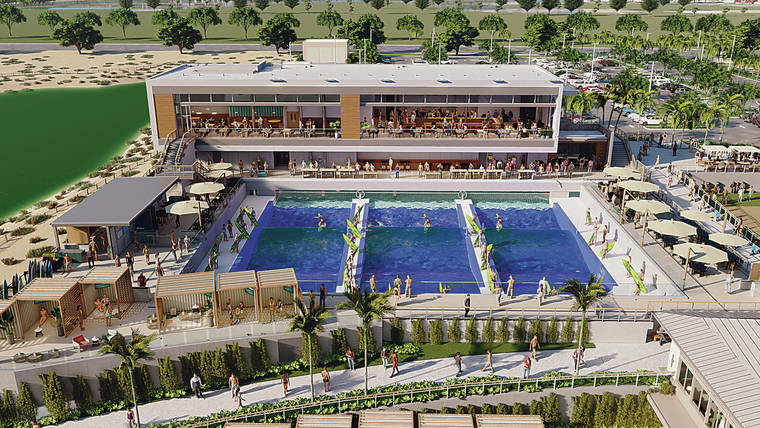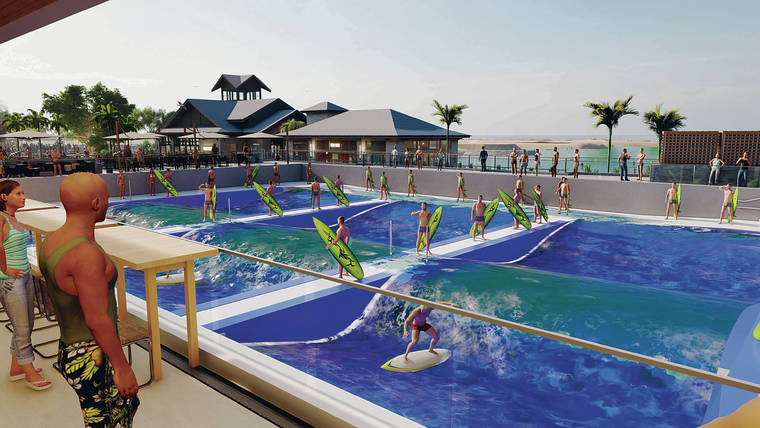A man-made surfing wave described as the widest stationary wave in the world is forecast to break in Hawaii.
The 100-foot-wide attraction has been drawn up as
a focal point of a revamped entertainment complex slated for Hoakalei Resort
in Ewa Beach.
An affiliate of Haseko
Development Inc., the developer of Hoakalei and the adjacent Ocean Pointe community, has been grading and excavating land next to its 52-acre Wai Kai Lagoon over the last three months for the wave park it expects to open in 2022.
The envisioned surf attraction using technology from Germany-based citywave is designed to generate a breaking, but not barreling, standing wave that can be adjusted from 2 to 6 1/2 feet in height in a basin a few feet deep. The wave can be generated as one long wave or partitioned into two or three sections for higher-
volume use.
Project officials say the attraction dubbed Wai Kai Wave will produce waves for entry-level to expert surfboard riders, as well
as for bodyboarding and bodysurfing. It can be used as a training facility and contest venue in addition
to recreation.
“It’s really going to be something,” said Larry Caster, Haseko’s director of retail development.
Local pro surfer and X Games gold medalist Shane Beschen, who is involved in the project, compares the artificial citywave to what can occur when the beach at Waimea Bay is occasionally breached by the Waimea River — but “on steroids.”
“This wave is killer for all skill levels,” he said. “Everything from high-speed carving turns to sections for attacking the lip or doing airs are all possible here.”
Citywave has 13 smaller facilities around the world, including one slated to open in April in Chelan, Wash., where it costs $35 to book a 45-minute session shared by up to a dozen surfers, or $370 for solo use.
Haseko plans to develop its surf attraction as part of an estimated $100 million
redrawn phase of a previously stalled $300 million
retail and entertainment project along the mauka edge of the lagoon.
Other pieces of the planned initial phase are a two-story restaurant for a James Beard Award-winning chef, a boutique apparel shop, a restaurant overlooking the surfing area,
293 parking stalls, a special events lawn, sand volleyball courts, a bar and coffee shop, a sandy beach area fronting part of the lagoon, and a dock to store equipment for use on the lagoon that includes stand-up
paddleboards, kayaks and canoes.
“It’s going to be a unique experience,” Caster said. “It’s going to be a super fun, dynamic environment for people just to come and hang out.”
In recent years there have been at least a couple of plans to develop a venue for surfing on large artificial waves in Hawaii, but none have come to fruition so far.
These endeavors include a surf village proposed on 19 acres of vacant state land in Kalaeloa with barreling waves advancing through a 5-acre lagoon, and a 400-room resort around a wave park once promoted for West Oahu.
Wet’n’Wild Hawaii, a water park in Kapolei, has a 40-foot-wide standing “sheet wave” made by rushing a few inches of water over a flexible hard surface.
Skip Taylor, a partner in California-based Surf Park Management, said the Wai Kai Wave his company will operate for Haseko combines the best aspects of surf parks worldwide.
“We’ve been able to take the best of what we found at all the other venues and combined it with the vision of the (Haseko team) to really build what we think is going to be a truly unique venue that will stand head and shoulders above any other surf park that exists in the world,” he said.
Haseko’s surf park complex represents the latest of several big revisions to the developer’s master plan for a 1,100-acre residential and resort community that dates back to the 1990s. The plan is permitted for up to 4,850 homes and 950 hotel, timeshare or vacation condominium units along with a golf course and commercial development.
To date, about 4,000 of the 4,850 homes have been built at Ocean Pointe and Hoakalei. The golf course opened in 2009.
Initially, the community’s defining centerpiece was to be a 120-acre boat marina that later was reduced in size by more than half.
The 20-foot-deep basin was finished in 2008 after six years of digging. But in 2011 before a channel to the ocean was excavated, Haseko announced that the basin, which was naturally filled by mainly fresh groundwater, would be a better community resource as a recreational lagoon for nonmotorized watercraft and with no outlet to the ocean.
The state Department of Health has prohibited swimming in the lagoon because it defines the body of water as a pool that does not meet a required water exchange rate, though Haseko studies show the water quality is better than some popular Oahu beaches.
Disgruntled homeowners sued Haseko over the marina-lagoon change, and a judge in 2018 awarded about 3,000 homeowners $20 million in damages, though an appeal is pending.
Amid the litigation, Haseko announced in 2017 an intent to build a retail village on 25 acres next to the marina with room for 110 tenants spread over 26 building clusters anchored by seven major restaurants, a specialty market, health club and spa.
Haseko projected that construction would begin in 2018 and finish by last year. However, the company didn’t carry through with that plan. The newly planned surf park complex is slated to occupy about a third of the former retail village site, or nine of 25 acres.
Caster said the plan now is to add more retail development later.
There is no timetable for proceeding with development of Hoakalei’s commercial resort element, which includes visitor accommodations around the lagoon, given the coronavirus pandemic and its damage to
Hawaii tourism.






